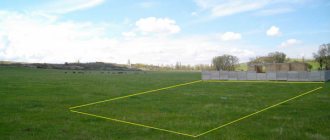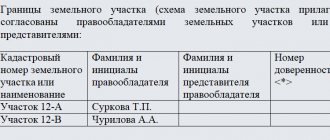Illegal seizure of land in state or private ownership has recently become a frequent occurrence in our daily life. Moreover, the problem remains relevant regardless of whether the appropriation of a park area or an individual plot occurs. At the legislative level, the authorities have considered this situation comprehensively and provide for liability for unauthorized occupation of a plot of land.
Dear readers! Our articles talk about typical ways to resolve legal issues, but each case is unique. If you want to find out how to solve your specific problem, please contact the online consultant form on the right. It's fast and free! Or call us at 8(800)-350-30-02 (the call is free for all regions of Russia)!
Article 7.1 unauthorized occupation of a land plot
Unauthorized occupation of a land plot is the possession by a third party of part or all of the plot if documentation confirming the right of ownership (purchase and sale agreement, resolution of local government bodies, lease agreement, etc.) cannot be provided as a basis.
If this reason is revealed, the plot must be immediately returned to the owner and the costs incurred by the unauthorized occupier will not be reimbursed.
Administrative liability for unauthorized occupation of a land plot arises in accordance with the Code of Administrative Offenses; Article 7.1 provides for fines for the lack of permits for the plot.
According to the notes to this article, if an individual entrepreneur takes possession of the land, he will be liable as a legal entity.
IMPORTANT! You need to know that land always has an owner. If it is not in the use and possession of citizens, organizations, municipalities, then it belongs to the state as a whole. This is stated in Article 16 of the RF Land Code.
If an unauthorized owner moved part of a fence or built a structure on someone else’s property, this will also be considered illegal.
If a person has taken possession of someone else’s land, then by virtue of Article 60 of the Land Code of the Russian Federation, the owner’s right to it must be restored. And also the plot must be returned to the owner in accordance with Article 76 of the said law, and all buildings must be demolished by the illegal user.
Civil legislation establishes a mandatory requirement to register ownership, as well as alienation, in the Rosreestr branch. At the same time, only a deed of gift or sale and purchase made orally (in writing) does not carry ownership rights.
The only relaxation the law gives is to lease and sublease agreements valid for up to a year. In this case, registration at the Rosreestr branch is not necessary.
Unauthorized occupation of land plots is the use of a land plot by an individual or legal entity until the boundaries of the land plot are established in kind (on the ground) and documents certifying the right of ownership, possession, use or lease are received in the prescribed manner. Unauthorized occupation of land is the most common violation of land legislation. The local government body may allow the use of land plots for agricultural purposes to begin before the issuance of the specified documents, provided that the boundaries of the land plot are indicated in kind (on the ground) with the delivery of a drawing (plan of the land plot). Responsibility for this type of offense is provided for in Art. 7.1 Code of Administrative Offenses of the Russian Federation. It establishes liability for violation of land legislation regulating the procedure for acquiring rights to land and the rights to carry out economic activities on land. This offense encroaches on legal relations associated with land as a natural object and natural resource, an important element of the environment. The direct object of encroachment is the ownership of land and the procedure established by the state for the emergence of rights to land and its use. The objective side of this offense is expressed in the commission of a number of illegal acts. This is: - unauthorized occupation of a land plot; - use of a land plot without registration of title documents for the land in accordance with the established procedure. Such documents in accordance with Art. 15 and 26 of the Land Code of the Russian Federation, as well as Art. 14 of the Federal Law of July 21, 1997 “On state registration of rights to real estate and transactions with it” are: - carrying out economic activities on a land plot without permits in cases where the legislation establishes the need to obtain them (Article 40 of the Land Code of the Russian Federation ); — certificates of state registration, which are issued to the copyright holder, tenant, mortgagee. The subjects of the offense may be citizens and legal entities who occupied a land plot without authorization, do not have title documents for the land plot or have committed another violation of land legislation, as well as officials who have not ensured the fulfillment of the established requirements for ownership and use of the land plot. From the subjective side, these acts are characterized by intentional guilt, that is, the person was aware of their illegality and wanted to carry them out. Compensation for damage caused by land offenses for unauthorized occupied land plots is made in accordance with Part 2 of Art. 76 of the Land Code of the Russian Federation to their owners, tenants, land users and landowners and is carried out by persons guilty of committing this offense or at their expense. Persons guilty of unauthorized occupation of a land plot are not reimbursed for expenses incurred during the illegal use of someone else's land plot. Affected citizens and legal entities have the right to recover from violators the amount of income they received during the period of illegal use of the land (Article I07 of the Civil Code of the Russian Federation). In Art. 7.1 of the Code of Administrative Offenses of the Russian Federation for unauthorized occupation of a land plot or use of a land plot without executed title documents for the land, and, if necessary, without documents permitting the implementation of economic activities, provides for: - the imposition of an administrative fine on citizens in the amount of five to ten minimum wages; - for officials - from ten to twenty minimum wages); - for legal entities 01 - from one hundred to two hundred minimum wages.
Responsibility for unauthorized occupation of land
The right to protection of property is proclaimed in the Constitution of the Russian Federation. Property can only be deprived by a court decision. It is legal to forcibly take away a plot if an equivalent replacement is provided. Property is protected by civil law, for example, by the provisions of Articles 209 and 218 of the Civil Code.
Article 218 indicates the alienation of a land plot through acquisition, donation, exchange or other transaction.
If the plot is alienated in another way, then such actions will be qualified as taking.
In case of unauthorized occupation of a land plot, judicial practice is on the side of the legal owner. To return property, you should contact the judicial authorities at the location of the property. The court takes into account, as important circumstances of the case, the time of acquisition, the grounds, the land plot itself, its location and purpose and the degree of guilt of the unauthorized owner, and also relies on the testimony of witnesses.
If the real owner has not shown interest in the site for a long time, he in any case cannot be deprived of it, and his rights must be protected.
Land may be recognized as ownerless on the basis of a resolution of local government bodies.
Punishment for unauthorized seizures
The seizure of the entire territory or only part of it does not matter; the violator is still obliged to bear responsibility, which is provided for by the legislation of the Russian Federation. The amount of the fine varies depending on the area of the site and its cadastral value, as well as on the subject of the offense.
As of 2020, it is equal to:
- Up to 1.5% of the cadastral value and at least 5 thousand rubles for ordinary citizens and individuals;
- For officials 2% of the amount and not less than 20 thousand rubles;
- Legal entities will be fined 100 thousand rubles and 2-3% of the cost.
It is necessary to understand that individual entrepreneurs in the event of committing such an offense are equated not to individuals, but to organizations. So the amount of the fine for them will be calculated as for legal entities. In 2020, responsibility for unauthorized seizure of land lies with all persons who did not bother to first obtain legal consent from the owner of the site for any work. If illegal squatting of land is detected, the violator will need to return the site to its original appearance. This applies to situations where there are changes in the earth. Based on a court decision, the culprit may be required to either demolish all erected buildings, regardless of their purpose, or the property may be confiscated and transferred to the victim as compensation.
In some cases, criminal liability may arise:
- Seizure of allotment is associated with another violation;
- The seizure was carried out as a result of fraudulent actions and deception;
- The rules of real estate turnover were ignored.
- The court's decision can be challenged if the offender does not agree with it.
The algorithm of actions for identifying self-capture usually includes several stages:
- The owner of the site discovers a violation and then contacts the government agency;
- The offender is given time during which he can voluntarily correct the problem. If this is a transfer of the boundaries of a site or a warehouse of property on someone else’s land, remove it, stop any activity on the land, demolish existing buildings;
- In a situation where the violation has not been eliminated during this period, a fine is imposed on the guilty person in the amount determined by law.
Even if a person has suffered an administrative penalty, this is not a guarantee that the victim will not demand compensation from him. Moreover, in practice, legal disputes in which a citizen has squatted are resolved in favor of the victim. So situations where the culprit is charged compensation in addition to a fine are not uncommon.
Fines for unauthorized occupation of land
Since March 2020, the minimum fines for unauthorized occupation of a land plot have increased 10 times for individuals, 20 times for officials, and 10 times for legal entities. Moreover, if a cadastral assessment of the site has been carried out, fines will be assigned as a percentage.
So, for taking over someone else’s land, individuals will have to pay 0.5-1 percent of the cost or 5,000-10,000 rubles, organizations - 1.2-2 percent, but not less than 100,000 rubles.
IMPORTANT! If we are talking about the acquisition of part of the land, the fine will be calculated proportionally.
As already noted, entrepreneurs must pay fines as legal entities.
Who, how and in what ways is responsible?
The Constitution of the Russian Federation, in Article 35, proclaims the protection of private property from any kind of encroachment. In addition, it is possible to lose this property only by a court decision. Forced alienation of property for the needs of the state is carried out only after equivalent preliminary compensation.
The rights of owners of land plots are protected by the Civil Code of the Russian Federation, for example, Article 209 of the Civil Code of the Russian Federation . Article 218 of the Civil Code describes the methods of alienation of land plots, through donation, exchange, purchase and sale or other legalized transaction.
If land is alienated in any other way, it means it falls under the concept of “squatting” and is punishable by law. In accordance with Article 1107 of the Civil Code of the Russian Federation, a person who saves unjustifiably, but otherwise received property, undertakes to compensate the real owner for the income derived from use, or income that will be received, from the moment the fact of illegal enrichment is disclosed.
A claim for reclaiming property is filed in court in the place where the disputed territory is located. The court considers the following facts: the legal ownership of the property in question by the plaintiff, the actual location of the disputed property with the defendant, the good faith of ownership of someone else’s property, and witness testimony.
The owner's long absence from the plot without an official voluntary renunciation (or through a judicial procedure) is not grounds for transferring the plot into ownership to another person.
It is possible to recognize the site as ownerless (only by local authorities!) - Decree of the Government of the Russian Federation of September 17, 2003 No. 580. Paragraph 8 of the Decree clarifies that the document that confirms the abandonment of property is a certified statement of such refusal.
Fines
There are fines for unauthorized seizure of land plots, which have been increasing since 2015. Now the law establishes the required amount of the fine as a percentage of the cadastral value. This means that the penalty for citizens will be in the amount of 1-1.5% of the cadastral value (but not less than 5,000 rubles). For companies - 2-3% (but not less than 100,000 rubles ).
If the cadastral price is not known (not determined), fines of a fixed amount are assessed from 5,000 to 10,000 for citizens, and from 100,000 to 200,000 rubles for companies. If we are talking about occupying only part of the land plot, then the fine will be calculated in proportion to the area of only this part.
In case of inappropriate use, the fines will be as follows: for citizens - 0.5 - 1%, not less than 10,000 rubles; for companies – 1.2-2%, not less than 100,000 rubles. Without cadastral value: for citizens – 10,000 – 20,000 rubles; for companies – 100,000-200,000 rubles. Repeated violation will result in increased penalties.
Capture examples
Let us consider, as an example, the facts of illegal seizure of nearby (and other) lands by persons who do not have legal rights to the seized lands.
The most flagrant violation of unauthorized occupation of a site is the construction of a permanent structure on land that does not belong to the owner of the illegal structure.
Such cases are far from uncommon. The calculations of citizens who expose themselves to such financial risks are completely incomprehensible, because they do not have many chances to legitimize the construction, and there are many more options to pay a fine and lose the building.
The demolition of an unauthorized building and bringing the land plot to its original condition is carried out at the expense of the citizens who erected the specified structure.
More common are situations with garages, especially those that were built before the adoption of new legislation.
Before the introduction of the Property Law, municipal lands adjacent to residential buildings were actively built up with illegal objects, mainly garages and outbuildings.
Subsequently, some of them were eliminated through demolition, others were privatized, and some of them remain in the status of unauthorized buildings to this day.
If you have an illegal building on municipal land, then after registering the rights to the building you will be able to obtain the legal right to use the land plot under its foundation.
In addition to the listed cases of illegal use, there are numerous, smaller violations of land occupation:
- On lands adjacent to the owner’s land plot by cultivating and using them.
- Failure to comply with the norms of indentation from linear objects.
- Storage of material outside of your own territory.
- Violation of boundary boundaries in relation to neighbors.
- Loss of old documents for the site being used.
We invite you to familiarize yourself with: Conclusion of a lease agreement for a forest plot || Extension of a forest lease agreement








